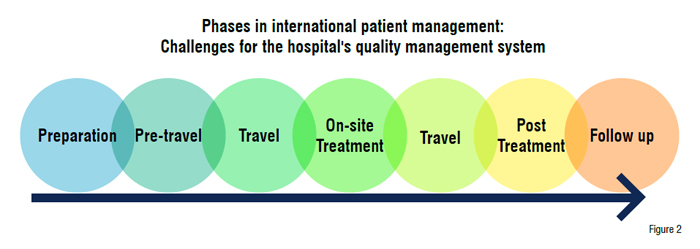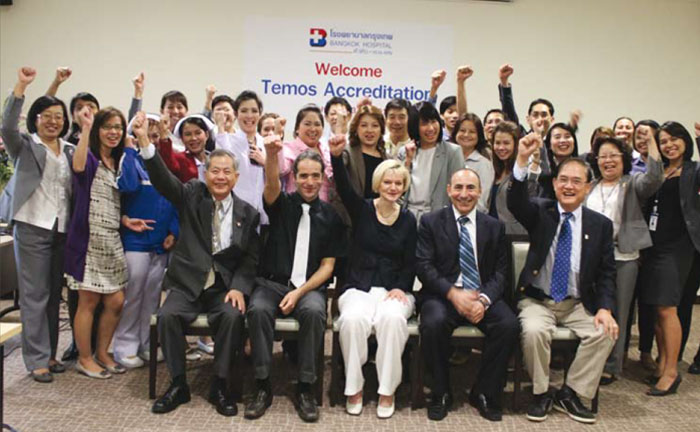
The medical tourism and tourism medicine market is an increasing but also challenging market. Patients have particular needs when undergoing treatment abroad. Pre-, on-site- and post-treatment take place in different countries and need to be managed to assure high quality and cost-effective medical care during all phases of the treatment process.
International patient management for expatriates, residents, and (business) travellers receiving healthcare services abroad and the processing of medical tourists are issues significantly raised in the past decades. These patient categories are characterised by unique requirements and needs when undergoing treatment outside of their own country. Pre-, on-site- and post-treatment take place in different countries and need to be adequately managed in order to assure high quality and cost-effective medical care at all stages of the care cycle.
Another important point is that the medical service structure and the operational and quality levels differ among countries depending on each country’s living standards, current regulatory, financial and organisational conditions. Moreover, quality is always relative due to the individual perception and culture and also due to the scientific or professional standards that are implemented.
Furthermore, difficulties in international patient management arise as a result of cultural differences, language barriers but also legal issues, different understanding of medicine or an interruption of cross-border procedures, for example, in the frame of the provision of reliable information and documentation in the pre-treatment stage.
The processes and procedures associated with the treatment of international patients need to be defined, implemented and realised in the frame of the healthcare facility’s Total Quality Management System (TQMS).
Treatment results and outcome data should be evaluated based on the medical facility’s quality criteria, Key Performance Indicators (KPIs) and data obtained from patient satisfaction surveys.
The importance of such elements for quality in international patient management beyond accreditation will be highlighted. Also emphasis will be made on the processes during the cycle of medical tourism from patient’s departure from their country, throughout medical care and treatment in the hospital until returning home. Furthermore, the following article summarises the essential quality criteria and patient satisfaction factors for international patients. The necessary tools for Continuous Quality Improvement (CQI) for medical tourism will be discussed to achieve a quality healthcare culture beyond accreditation and beyond boarders.
These principles and best practices are based on certification experience from hospitals with large numbers of international patients and from the involved Temos assessors working with different hospitals in different countries internationally.

Quality and safety are the most essential requirements for providing an optimum healthcare support for accreditation and QMS systems. Since it relates to medical tourism, a third dimension is needed, concerning the quality culture with all its aspects of medical and non-medical operations. As such, hospitals in some countries within the frame of the medical tourism industry have been competing recently for quality culture to capture the attention of international patients, health insurance and facilitator companies. However, at the end the objective of healthcare organisations should be the gain of trust and then meet or even exceed inbound patient expectations and satisfaction.
Looking at the overall picture of international patient care, accreditation standards cover the main departments of the healthcare organisation for the minimum requirements of healthcare services. However, for medical tourism, additional criteria and elements are required to cover inter-cultural boundaries. These elements include culture sensitivity of the personnel including nurses, doctors and involved administrative staff, language skills, food quality and flexibility, and the procedures before, during and after the treatment followed by discharge policies and, importantly, adequate documentation in the required language.
The whole objective is to achieve optimum multicultural services for the highest quality of care and safety with adopted cultural elements. Besides the non-medical dimensions of healthcare, the clinical or medical outcome of the service itself progressively becomes an objective measure for competition among healthcare providers worldwide. Different hospitals promote their clinical effectiveness and high rates of ‘extraordinary’ effects of various treatments or diagnostic procedures and those points seem to be rather persuasive when it comes to patient’s decision in the choice of a medical service provider.
Thus, accreditation is an important part of the establishment of a general and basic quality culture for healthcare service providers. For medical tourism and international patient management, healthcare providers need to go a step further.

International patient management is confronted with a number of challenges to achieve higher patient satisfaction rates. When a patient travels to get treatment abroad, he or she expects to have a high level of quality healthcare services, a minimal risk of medical mistakes or malpractice, and safe, effective and appropriate treatment.
From the patient’s side, there may be different barriers. These include unsure quality, unknown physicians and hospital personnel skills, different and unknown food, different culture and language, different religious handling of deceased patients, questionable infection control levels, uncertainty regarding surroundings and adjustment to the environment as well as difficulties in the continuity of care. Furthermore, billing and accounting might be a challenge for the patient who is not familiar with the local system.
From the hospital’s side there are also significant factors to be properly handled which include unknown real conditions of the patient and the respective medical history, infection control issues, difficulties in the follow-up and after-treatment care, payment of services after discharge and other related issues.
In any case, proper management of international medical tourist services, which include internal and external communication, the implementation and realisation of guidelines as well as internal protocols, can bridge the gap between the international patients’ demands and the hospital’s requirements for the provision of these services. At the end both sides will benefit by achieving their objectives.
Despite the above mentioned requirements and challenges for the management of international patients, there are positive impacts to the nation receiving international patients by properly managing their discrete needs for special services.
Effects might include social, financial and industrial impact. On the social front, international patient management experience leads to more employment opportunities in the country, more positive competition between hospitals to provide effective and affordable healthcare in addition to industrial growth.
From the financial aspects it promotes industries, foreign investment business experts, and foreign currencies and contributes positively to the GDP. On the industrial side, several industries are significantly impacted by its growth and development; these include the hotel industry, tourism, pharmaceutical and other private and public sectors. On the other hand, there may be negative impact to the nation in case relevant risks are not well managed and treated. These include possible communicable diseases, constrains on the country healthcare for its own citizens and uncertain reimbursement to the hospitals that can be due to political situations.

The experience of the Temos assessors in auditing different hospitals of different categories all over the world has shown that system planning and a respective structure are usually based on the currently existing situations. These are related to local residents depending on a particular pre-defined model for potential needs or required services.
International patients are expected to be covered through the existing operational systems not taking under consideration the particularities accompanying the international patient. In the frame of the Temos certification process, healthcare providers have the opportunity to learn basic methodologies and the importance of risk assessment procedures in the direction of defining the most suitable system to adequately meet international patients’ needs including and combining the local and international perspective for high quality services.
The most typical example from the hospitals' perspective is the infection control system which has to integrate pre-screening guidelines and protocols for the admission of patients depending on the country of origin and provenance. Furthermore, the existing infection control system might need to be extended due to the fact that pathogenic germs travel with the patients and do not stop at the border.
Since most of the international medical tourists are laypersons regarding the validation of the medical quality, the non-clinical services are mainly the determining factors for patient satisfaction. Beside others, nursing services, availability of doctors, cultural sensitivity and also food are important factors for patients' satisfaction. Many healthcare providers experienced in medical tourism are aware of these factors and have implemented such measures in their TQMS programmes.
Risk assessment methodologies derived from the Temos certification quality criteria framework are considered as the basis for every standard operational procedure and / or programme. This is usually scheduled and mostly implemented either within the medical or non-medical and supportive services of the healthcare provider. Hospital professionals throughout the certification process become aware of the significance of risk identification in order to plan and execute particular measures for the effective and direct management of risks with regards to the international patients’ physical and general safety.
Moreover, during the certification process and preparation of the hospital, it is realised that promoting the healthcare services in the international market requires enhanced evidence-based competitive factors. These factors include measuring and continuous monitoring of clinical effectiveness, medical staff credentials for specialisation and experience as well as proven and documented hospital policies and procedures regarding Continuous Medical Education (CME) programmes and specified internal training programmes.
International patients’ travel for treatment abroad is on the rise with a rapid pace in some countries. Other healthcare providers or even countries may not profit from these developments.
The experts’ opinions differ. Does this industry which is one of the newest in this decade significantly contribute to improving the well-being of patients and help them financially? Are the benefits for hospitals and nations with a medical tourism industry convincing and practicable?
The realisation of the following five points may already help to regulate the market to the good / benefit of the patients and the service providers:
This can include service requirements, pricing, payments and monitoring of the services but also regional conferences to continuously address the challenges in medical tourism
1. Ensuring the availability of legal medical liability in the country receiving international patients
2. Establishing medical tourism clusters that include hospitals, governments, hotels, tourism and other stakeholders to define interfaces, improve and optimise services
3. Emphasising on certification of hospitals for medical tourism in addition to accreditation. International patient management certification can give assurance to patients and the receiving country in terms of neutral assessment and the provision of best services to the patients. It also helps hospitals improve the service quality for the international patient-based on best practices in the industry
4. Emphasising on communication between the service providers and the patient during all phases of the patient’s care cycle by maintaining a multi-language, interactive and service website, and a communication system within the hospital system and to all externally involved parties.
These points, as well as quality management, and continuous quality improvement programmes are essential to ensure patient safety and formulate an optimal international patient management in this new industry.
In the end, patients will decide about the future of this evolving and ‘alternative’ market.